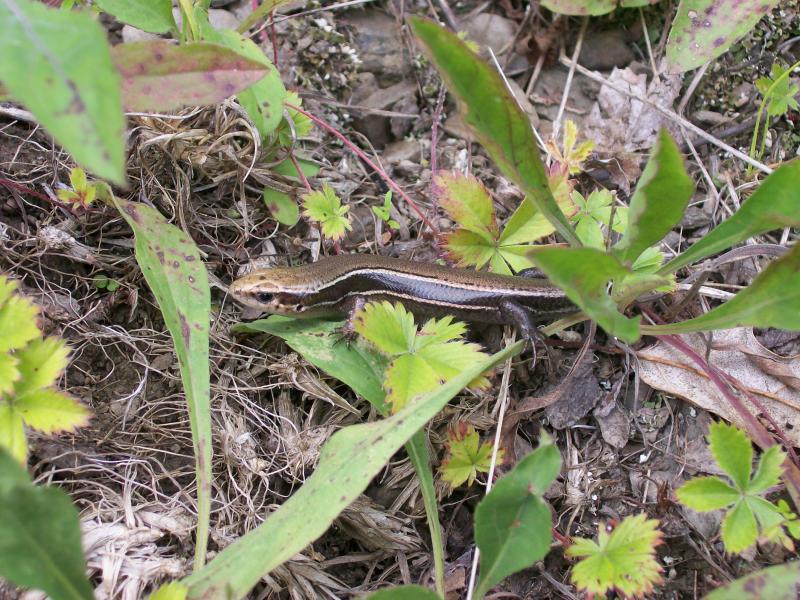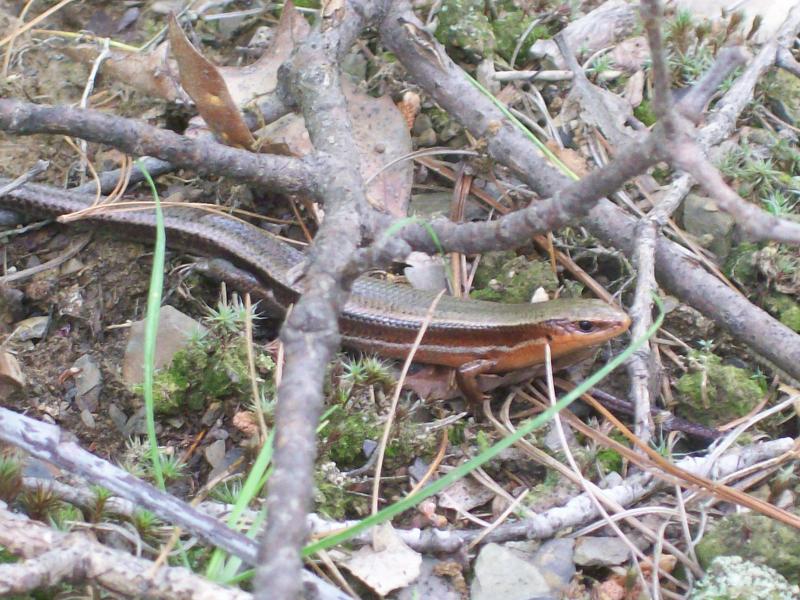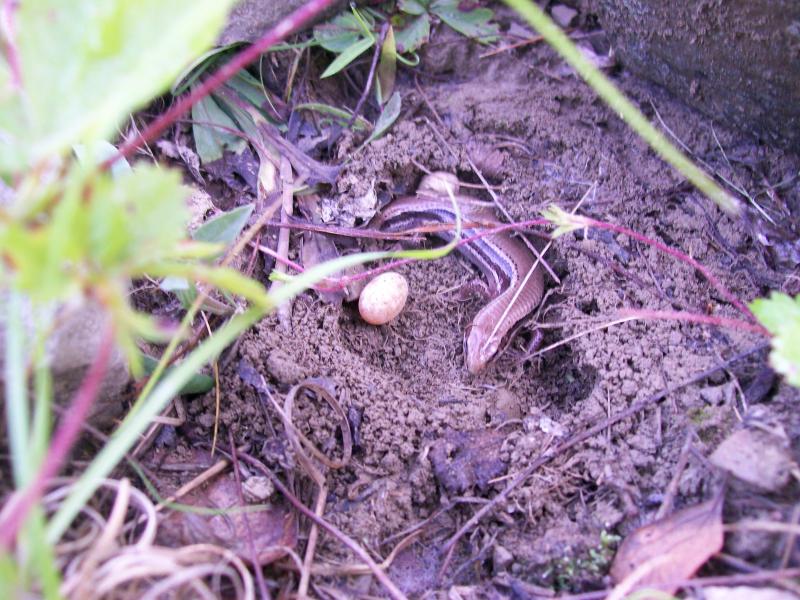Coal Skink
Plestiodon anthracinus Baird, 1849 [or 1850]
- Class
- Reptilia (Reptiles)
- Family
- Scincidae (Skinks)
- State Protection
- Game with no open season
Defined as a Game species (other than birds) by New York State law, but there are no open seasons set and the species may not be hunted or taken at any time in New York.
- Federal Protection
- Not Listed
- State Conservation Status Rank
- S2S3
Imperiled or Vulnerable in New York - Very vulnerable, or vulnerable, to disappearing from New York, due to rarity or other factors; typically 6 to 80 populations or locations in New York, few individuals, restricted range, few remaining acres (or miles of stream), and/or recent and widespread declines. More information is needed to assign either S2 or S3.
- Global Conservation Status Rank
- G5
Secure globally - Common in the world; widespread and abundant (but may be rare in some parts of its range).
Summary
Did you know?
In order to avoid predation, coal skinks are able to drop off a piece of their tail to escape or distract predators.
State Ranking Justification
Certainly fewer than 20 locations have been documented. Populations are probably localized as some of the known habitats are unusual wetlands or ridgetops. However, presence in cutover woods at one site combined with its secretive nature suggests more occurrences may exist. No concerted inventory efforts for the species are known.
Short-term Trends
The short-term trends for this species in New York are unknown, but it appears the populations are stable or possibly declining. Coal skinks are known from only ten locations in the state, as well as two historical locations.
Long-term Trends
Long-term trends are unknown, but are likely stable or possibly declining.
Conservation and Management
Threats
Coal skinks in New York seem to prefer somewhat open habitats including talus slopes, rocky openings, and early successional habitats (Titus et al. 2010). Succession to higher percents of woody cover can make habitats unsuitable for skinks. Habitat destruction and fragmentation are also threats.
Conservation Strategies and Management Practices
There are several conservation strategies that would serve to conserve and improve habitats for coal skinks. One of the most important conservation strategies for these skinks is to conserve known sites and ensure sites remain somewhat open. Controlling woody vegetation, including invasives, and introducing frequent disturbances to the habitat may be necessary (Titus et al. 2010). Titus et al. (2010) found that shrub cover was significantly less at sites with coal skinks than at sites where skinks formerly occurred but no longer seem to occur. Habitat management activities should be spaced out every several years and done at times that are not likely to endanger the skinks. Other management practices that will improve habitats for skinks are to leave stumps, logs, and other coarse woody debris following timber harvests or other management activities, and ensure that the forest floor structure is maintained in as natural a state as possible (Mitchell et al. 2006). Avoid fragmentation of large blocks of forests with roads, field crops, developments, and other barriers between them. Management activities should strive to protect habitat features within occupied forests, such as vernal pools, springs, seepages, and rock outcrops (Mitchell et al. 2006). Prevent or reduce ATV usage in areas with coal skink populations to reduce mortality.
Research Needs
Search for new populations of skinks and determine their distribution throughout New York. Estimate coal skink populations at sites with the most stable populations.
Habitat
Habitat
Coal skinks can be found in habitats near water, most frequently moist forested areas near swamps and other wetlands (Gibbs et al. 2007). Sometimes the skinks are found on dry rocky hillsides and shale barrens with water nearby. Habitats must include plenty of cover objects, such as boards, logs, leaf litter, and loose flat rocks. Sometimes they take refuge in water. One nest was under a piece of shale (Mount 1975).
Associated Ecological Communities
- Shale cliff and talus community
(guide)
A community that occurs on nearly vertical exposures of shale bedrock and includes ledges and small areas of talus. Talus areas are composed of small fragments that are unstable and steeply sloping; the unstable nature of the shale results in uneven slopes and many rock crevices.
- Shale talus slope woodland
(guide)
An open to closed canopy woodland that occurs on talus slopes composed of shale. These slopes are rather unstable, and they are usually very well-drained, so the soils are shallow and dry. The canopy cover is usually less than 50%, due to the instability of the substrate.
Range
New York State Distribution
Recent records from 5 of 57 counties (9%) plus older records from several others. All records are from the central western part of the state (lake plains and southern tier). Populations appear to be quite localized.
Global Distribution
Coal skinks occur in fragmented populations from eastern Texas to the Florida panhandle, north to eastern Kansas and western New York (NatureServe 2018).
Identification Comments
Identifying Characteristics
These skinks have smooth, shiny scales and a brown or greenish back (Gibbs et al. 2007). They have two wide dark brown or black stripes running along the side of the body bordered by bright yellowish stripes. Males can get a reddish coloration along the jaws and sides of the head during breeding season. Juvenile skinks have a blue or dark violet tail.
Best Life Stage for Proper Identification
Adult.
Behavior
These skinks are mostly diurnal. In order to avoid predation, coal skinks are able to drop off a piece of their tail to escape or distract predators.
Diet
Coal skinks eat small invertebrates such as spiders, small insects, and insect larvae
Best Time to See
Coal skinks breed from April - May in New York when they seem to be most observable, but they remain active throughout the summer and fall.
- Present
- Active
- Reproducing
The time of year you would expect to find Coal Skink present, active, and reproducing in New York.
Similar Species
- Five-lined Skink (Plestiodon fasciatus)
Common five-lined skinks have two postmental scales on the undersides of the jaw, while coal skinks only have one. Younger common five-lined skinks may have a pair of converging light stripes on the top of the head, which the coal skink lacks.
Coal Skink Images
Taxonomy
Coal Skink
Plestiodon anthracinus Baird, 1849 [or 1850]
- Kingdom Animalia
- Phylum Craniata
- Class Reptilia
(Reptiles)
- Order Squamata
(Lizards, Snakes and Amphisbaenians)
- Family Scincidae (Skinks)
- Order Squamata
(Lizards, Snakes and Amphisbaenians)
- Class Reptilia
(Reptiles)
- Phylum Craniata
Additional Resources
References
Gibbs, J.P., A.R. Breisch, P.K. Ducey, G. Johnson, J.L. Behler, and R.C. Bothner. 2007. The amphibians and reptiles of New York State. Oxford University Press, NY.
Mitchell, J.C., A.R. Breisch, and K.A. Buhlmann. 2006. Habitat management guidelines for amphibians and reptiles of the northeastern United States. Partners in Amphibian and Reptile Conservation, Technical Publication HMG-3, Montgomery, Alabama. 108 pp.
Mount, R. H. 1975. The reptiles and amphibians of Alabama. Auburn University Agricultural Experiment Station, Auburn, Alabama. vii + 347 pp.
New York Natural Heritage Program. 2024. New York Natural Heritage Program Databases. Albany, NY.
New York State Department of Environmental Conservation. 1985. Checklist of the amphibians, reptiles, birds, and mammals of New York State, including their protective status. Nongame Unit. Wildlife Resources Center. Delmar, NY.
Titus, Christopher M., Christopher Norment, and Joseph Makarewicz. 2010. The coal skinks of western and central New York: habitat use and population status. Final report and data files submitted to the New York Natural Heritage Program. Contract #: NYHER 080812. Research Foundation of State University of New York College at Brockport.
Links
About This Guide
This guide was authored by: Ashley R. Ballou
Information for this guide was last updated on: November 30, 2018
Please cite this page as:
New York Natural Heritage Program. 2024.
Online Conservation Guide for
Plestiodon anthracinus.
Available from: https://guides.nynhp.org/coal-skink/.
Accessed April 24, 2024.


